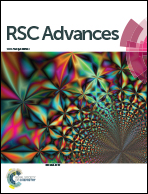Design and characterization of a microbial self-healing gel for enhanced oil recovery†
Abstract
Due to the heterogeneity of rock layers, the poor volumetric sweep efficiency of water and an invalid cycle have emerged as major problems in crude oil production. In this study, Sporosarcina pasteurii, the ureolytically active microorganisms, and the concentrated substrate were immobilized into the gels while the microorganisms could metabolize to produce ammonium, carbonate and EPS. The optimum immobilization formula was determined according to the microbial activity by detecting the ammonium concentration. Furthermore, the microscope images showed the uniform distribution of the microorganisms in the gels and the porosity of gels was propitious to the immobilization of the microorganisms. The reaction of precipitation happened immediately as soon as the carbonate anion was generated by the microorganisms in the gels and the EPS acted as not only an adhesive agent but also the nucleus of precipitation. As a consequence, the broken gels were healed again via the synergistic bridge effect among gel, calcium carbonate and EPS. In addition, the strength analysis revealed the excellent performance of self-healing gel and sand-packed columns experiment showed an improvement of oil recovery from 45.37% to 88.32%. This microbial self-healing gel shows a promising application prospect to enhanced oil recovery.



 Please wait while we load your content...
Please wait while we load your content...